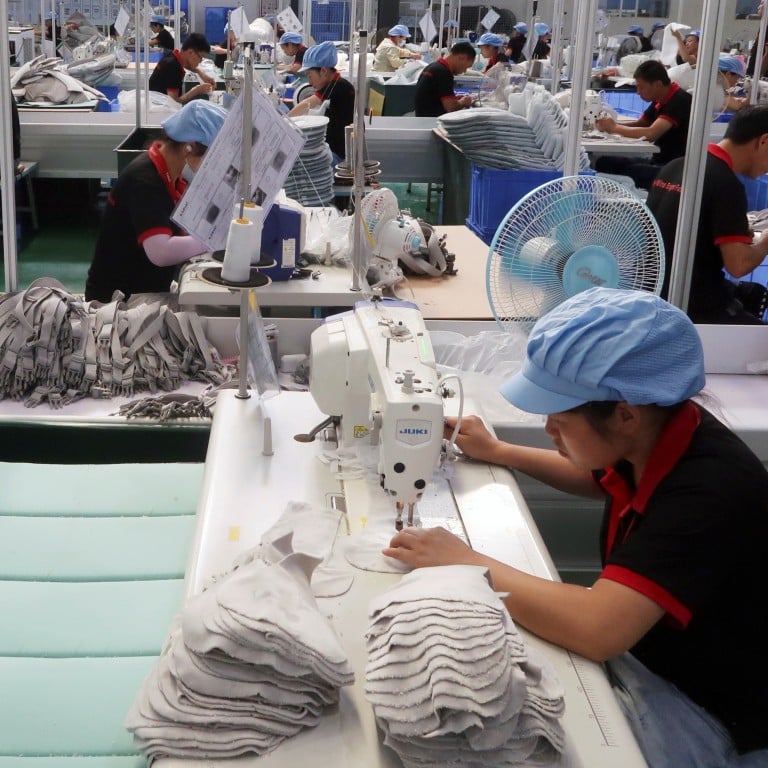
China’s slowing economic growth signals fiscal spending could continue into second half of year
- China’s economy grew by 7.9 per cent in the second quarter from a year earlier, down from 18.3 per cent growth in the first three months
- As economic headwinds grow in the back half of the year, there are mixed forecasts on whether the government is likely to loosen monetary policy
China is likely to stay on course with fiscal spending to shore up its slowing economy, analysts say, after a solid second-quarter economic performance did little to assuage concerns about a bumpy road ahead in the second half of the year.
They also expect policymakers to encourage consumer spending. Economic figures released on Thursday showed retail sales – a key measurement of consumer spending – grew by 12.1 per cent year on year in June, down from a 12.4 per cent increase in May, but above the 10.8 per cent rise expected by analysts in a Bloomberg survey.
Overall, China’s economy grew by 7.9 per cent in the second quarter of the year compared with a year earlier – in line with analysts’ expectations of 8 per cent growth – to post an expansion of 12.7 per cent in the first half of the year.
Headwinds to growth are likely to intensify during the second half of the year
“All told, activity in China remained strong in the second quarter. But with output already above its pre-virus trend, the economy is struggling to gain ground at its usual pace,” said Julian Evans-Pritchard, senior China economist at Capital Economics.
“Headwinds to growth are likely to intensify during the second half of the year. China’s Covid-19 export boom appears to have peaked and will unwind over the coming quarters as vaccine roll-outs and reopening help to normalise global consumption patterns.”
While China’s central bank has made efforts to reverse slowing credit growth, which impedes spending, there are no signs of a further relaxation in lending and liquidity ahead, Evans-Pritchard said.

01:19
China’s economy rose 7.9 per cent year on year in the second quarter of 2021
David Chao, global market strategist for Asia Pacific (ex-Japan) at Invesco, said a full recovery to pre-Covid conditions may take longer than expected.
“This may be why the government recently pivoted towards a more supportive monetary policy to nudge certain segments of the economy along,” Chao said.
In particular, China has been focused on reviving the manufacturing and infrastructure sectors, but with consumer spending slowing down and consumers switching to spending on services, small and medium-sized firms are struggling to make ends meet.
This is in line with warnings from key economic commentators, such as former Chinese finance minister Lou Jiwei, who late last year warned the world’s second largest economy was in dire straits, pointing to high debt across the economy.
“As far as China’s finances are concerned, the situation is severe, and there are huge risks and challenges,” he said in a speech to a financial panel.
“This is not limited to a slowdown in economic growth but the slowing growth of fiscal revenue … the ageing population. Debt poses a severe challenge to fiscal sustainability. ”
On Wednesday, Pinpoint Asset Management chief economist Zhang Zhiwei also highlighted other worrying signs in retail sales. He said in May, four out of China’s 28 provincial capitals experienced a drop in retail spending.
“Before the epidemic, the total retail sales in these cities had never seen negative growth,” he said in a note. “Even when the epidemic was severe last year, there were only a few months of negative growth, and it had turned positive in the second half of the year.”
Many analysts do not expect further monetary policy changes this year, with fiscal spending continuing.

04:14
Xi Jinping leads celebrations marking centenary of China’s ruling Communist Party
Zhu Haibin, JP Morgan’s chief China economist, said he did not expect another cut to the reserve requirement ratio (RRR) or an interest-rate cut.
Invesco’s Chao said policymakers will push forward on the fiscal stimulus front with an acceleration in infrastructure investment spending, driven by bonds issued by local government financing vehicles.
Su Yue, principal China economist at The Economist Intelligence Unit, said policies to boost domestic consumption will be introduced, targeting sectors which have potential to grow further such as home appliances and tourism.
“The authorities are unlikely to relax policy for house purchases and investment, because curbing lending to house speculation helped little with directing financing to other industries such as manufacturing so far,” she said. “Fiscal support will go to key infrastructure projects of the 14th Five Year Plan.”
The outlook for the consumption and service sector in the second half is concerning
Economists from ANZ Research said, however, the authorities will try to maintain ample liquidity, although this comes with heightened credit risks.
“Today’s data release confirms that China’s growth momentum is uneven. The outlook for the consumption and service sector in the second half is concerning and may prompt the authorities to launch targeted supportive measures,” ANZ Research analysts Raymond Yeung, Betty Wang and Zhaopeng Xing said in a note.
“Policymakers will focus on boosting the recovery of the domestic market … on the monetary policy front, the preference will be on renminbi interest rate rather than the exchange rate, in our view.”


